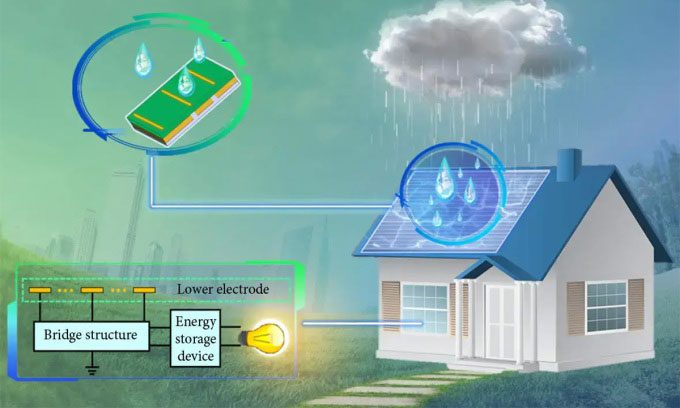A Research Team from Tsinghua University Proposes Improvements to Rain Energy Harvesting Devices for Large-Scale Implementation.
When raindrops fall from the clouds, they generate a small amount of energy that can be captured and converted into electricity. This process can be considered a form of mini-hydropower, utilizing the kinetic energy of moving water to produce electricity. However, scaling this technology for broader application poses challenges, limiting its practical use.

Simulation of D-TENGs generating electricity from rain. (Photo: iEnergy/Tsinghua University Press).
To harness the energy from rain, experts utilize a device known as a triboelectric nanogenerator (TENG), which facilitates the electrification of liquid-solid contact. However, drop-type TENGs (D-TENGs) face technical limitations when connecting multiple units, which diminishes overall electricity output. A recent study published in the journal iEnergy presents a method for modifying D-TENG devices akin to solar panels, enhancing the efficiency of rain energy harvesting, as reported by SciTechDaily on August 1.
“D-TENGs have an extremely high output of electricity, yet it remains challenging for a single D-TENG to provide continuous power to megawatt-level electrical devices. Thus, realizing the simultaneous use of multiple D-TENGs is essential. Based on the design of solar panels, where multiple generating units are connected in parallel to supply power, we propose a simple and effective method to harvest energy from raindrops,” stated Zong Li, a professor at Tsinghua University in China.
When multiple D-TENGs are connected, there can be unintended capacitive coupling between the upper and lower electrodes of the energy collection panel. This unintended capacitive coupling reduces the output power of the D-TENG. To mitigate this issue, the research team proposed panel-type generators linked similarly to solar panels, utilizing the lower electrodes of the energy collection panel to lessen the impact of capacitance.
“The peak output electricity of the panel-type generators is nearly 5 times higher than the electricity harvested from rain using traditional devices of the same size, reaching 200 watts per m2, demonstrating the advantages of the new device. The results of this research provide a viable solution for widespread rain energy harvesting,” Li remarked.


















































